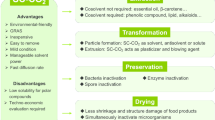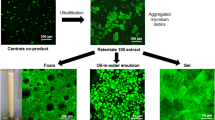Abstract
Supercritical carbon dioxide (SC-CO2) treatment is one of the most promising alternative techniques for pasteurization of both liquid and solid food products. The inhibitory effect of SC-CO2 on bacterial growth has been investigated in different species, but the precise mechanism of action remains unknown. Membrane permeabilization has been proposed to be the first event in SC-CO2-mediated inactivation. Flow cytometry, high performance liquid chromatography–electrospray ionization–mass spectrometry and NMR analyses were performed to investigate the effect of SC-CO2 treatment on membrane lipid profile and membrane permeability in Escherichia coli K12. After 15 min of SC-CO2 treatment at 120 bar and 35 °C, the majority of bacterial cells dissipated their membrane potential (95 %) and lost membrane integrity, as 81 % become partially permeabilized and 18 % fully permeabilized. Membrane permeabilization was associated with a 20 % decrease in bacterial biovolume and to a strong (>50 %) reduction in phosphatidylglycerol (PG) membrane lipids, without altering the fatty acid composition and the degree of unsaturation of acyl chains. PGs are thought to play an important role in membrane stability, by reducing motion of phosphatidylethanolamine (PE) along the membrane bilayer, therefore promoting the formation of inter-lipid hydrogen bonds. In addition, the decrease in intracellular pH induced by SC-CO2 likely alters the chemical properties of phospholipids and the PE/PG ratio. Biophysical effects of SC-CO2 thus cause a strong perturbation of membrane architecture in E. coli, and such alterations are likely associated with its strong inactivation effect.






Similar content being viewed by others
References
Ballestra P, Abreu Da Silva A, Cuq JL (1996) Inactivation of Escherichia coli by carbon dioxide under pressure. J Food Sci 61:829–836
Berney M, Weilenmann HU, Egli T (2006) Flow-cytometric study of vital cellular functions in Escherichia coli during solar disinfection (SODIS). Microbiol 152:1719–1729
Boggs JM (1987) Lipid intermolecular hydrogen bonding: influence on structural organization and membrane function. Biochim Biophys Acta 906:353–404
Clifford AA, Williams JR (2000) Introduction to supercritical fluids and their applications. In: Williams JR, Clifford AA (eds) In supercritical fluid methods and protocols. Human Press Inc., Totowa, NJ, pp 1–16
Damar S, Balaban O (2006) Review of dense phase CO2 technology: microbial and enzyme inactivation, and effects on food quality. J Food Sci 71(1):R1–R11
Devlieghere F, Vermeiren L, Debevere J (2004) New preservation technologies: possibilities and limitations. Int Dairy J 14:273–285
Ferrentino G, Spilimbergo S (2011) High pressure carbon dioxide pasteurization of solid foods: current knowledge and future outlooks. Trends Food Sci Technol 22:427–441
Foladori A, Quaranta A, Ziglio G (2008) Use of silica microspheres having refractive index similar to bacteria for conversion of flow cytometric forward light scatter into biovolume. Water Res 42:3757–3766
Garcia-Gonzalez L, Geeraerd AH, Spilimbergo S, Elst K, Van Ginneken L, Debevere J, Van Impe JF, Devlieghere F (2007) High pressure carbon dioxide inactivation of microorganisms in foods: the past, the present and the future. Int J Food Microbiol 117:1–28
Garcia-Gonzalez L, Geeraerd AH, Mast J, Briers Y, Elst K, Van Ginneken L, Van Impe JF, Devlieghere F (2010) Membrane permeabilization and cellular death of Escherichia coli, Listeria monocytogenes and Saccharomyces cerevisiae as induced by high pressure carbon dioxide treatment. Food Microbiol 27:541–549
Garidel P, Christof C, Mennicke L, Blume A (1997) The mixing behavior of pseudobinary phosphatidylcholine-phosphatidylglycerol mixtures as a function of pH and chain length. Eur Biophys J 26:447–459
Isenschmid A, Marison IW, von Stockar U (1995) The influence of pressure and temperature of compressed CO2 on the survival of yeast cells. J Biotechnol 39:229–237
Jones RP, Greenfield PF (1982) Effect of carbon dioxide on yeast growth and fermentation. Enzyme Microb Technol 4:210–223
Kim SR, Kim HT, Park HJ, Kim S, Choi HJ, Hwang GS, Yi JH, Ryu DH, Kim KH (2009) Fatty acid profiling and proteomic analysis of Salmonella enterica serotype Typhimurium inactivated with supercritical carbon dioxide. Int J Food Microbiol 134:190–195
Leekumjorn S, Sum AK (2006) Molecular investigation of the interactions of trehalose with lipid bilayers of DPPC, DPPE and their mixture. Mol Simul 32:219–230
Liao H, Zhang F, Hu X, Liao X (2011) Effects of high-pressure carbon dioxide on proteins and DNA in Escherichia coli. Microbiology 157:709–720
Lin HM, Yang ZY, Chen LF (1993) Inactivation of Leuconostoc dextranicum with carbon dioxide under pressure. Chem Eng J 52:B29–B34
Lu YH, Guan Z, Zhao J, Raetz CRH (2011) Three Phosphatidylglycerol-phosphate phosphatases in the inner membrane of Escherichia coli. J Biol Chem 286:5506–5518
Mantoan D, Spilimbergo S (2011) Mathematical modeling of yeast inactivation of freshly squeezed apple juice under high-pressure carbon dioxide. Crit Rev Food Sci Nut 51:91–97
Morein S, Andersson AS, Rilfors L, Lindblom G (1996) Wild-type Escherichia coli cells regulate the membrane lipid composition in a “window” between gel and non-lamellar structures. J Biol Chem 271(12):6801–6809
Müller S, Nebe-von-Caron G (2010) Functional single-cell analyses: flow cytometry and cell sorting of microbial populations and communities. FEMS Microbiol Rev 34(4):554–587
Pink DA, McNeil S, Quinn B, Zuckermann MJ (1998) A model of hydrogen bond formation in phosphatidylethanolamine bilayers. Biochim Biophys Acta 1368:289–305
Sahena F, Zaidul ISM, Jinap S, Karim AA, Abbas KA, Norulaini NAN, Omar AKM (2009) Application of supercritical CO2 in lipid extraction—a review. J Food Eng 95:240–253
Slonczewski JL, Fujisawa M, Dopson M, Krulwich TA (2009) Cytoplasmic pH measurement and homeostasis in bacteria and archaea. Adv Microb Physiol 55:1–79
Spilimbergo S, Bertucco A (2003) Non-thermal bacteria inactivation with dense CO2. Biotech Bioeng 84(6):627–638
Spilimbergo S, Mantoan D, Quaranta A, Della Mea G (2009) Real-time monitoring of cell membrane modification during supercritical CO2 pasteurization. J Supercrit Fluids 48:93–97
Spilimbergo S, Quaranta A, Garcia-Gonzalez L, Contrini C, Cinquemani C, Van Ginneken L (2010) Intracellular pH measurement during high-pressure CO2 pasteurization evaluated by cell fluorescent staining. J Supercrit Fluids 53:185–191
Tamburini S, Ballarini A, Ferrentino G, Moro A, Foladori P, Spilimbergo S, Jousson O (2013) Comparison of quantitative PCR and flow cytometry as cellular viability methods to study bacterial membrane permeabilization following supercritical CO2 treatment. Microbiol 159:1056–1066
Tari A, Huang L (1989) Structure and function relationship of phosphatidylglycerol in the of phosphatidylethanolamine bilayer. Biochem 28:7708–7712
Weber FJ, de Bont JAM (1996) Adaptation mechanisms of microorganisms to the toxic effects of organic solvents on membranes. Biochim Biophys Acta 1286:225–245
Zhang YM, Rock CO (2008) Membrane lipid homeostasis in bacteria. Nat Rev 6:222–233
Zhao W, Ròg T, Andrey A, Gurtovenko AA, Vattulainen I, Karttunen M (2008) Role of phosphatidylglycerols in the stability of bacterial membranes. Biochimica 90:930–938
Ziglio G, Andreottola G, Barbesti S, Boschetti G, Bruni L, Foladori P, Villa R (2002) Assessment of activated sludge viability with flow cytometry. Water Res 36:460–468
Author information
Authors and Affiliations
Corresponding author
Electronic supplementary material
Below is the link to the electronic supplementary material.
Rights and permissions
About this article
Cite this article
Tamburini, S., Anesi, A., Ferrentino, G. et al. Supercritical CO2 Induces Marked Changes in Membrane Phospholipids Composition in Escherichia coli K12. J Membrane Biol 247, 469–477 (2014). https://doi.org/10.1007/s00232-014-9653-0
Received:
Accepted:
Published:
Issue Date:
DOI: https://doi.org/10.1007/s00232-014-9653-0




